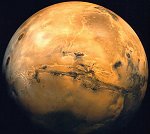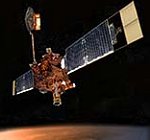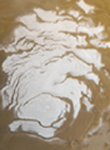| Space News |
| http://www.sina.com.cn 2004/09/21 14:04 冰岩双语文化工作室 |
语音讲解: EXPLORATIONS - Space News By Paul Thompson Broadcast: December 25, 2003 (THEME) VOICE ONE: This is Steve Ember. VOICE TWO:
Mars(photo courtesy NASA/JPL) And this is Nicole Nichols with the VOA Special English program EXPLORATIONS. Today we report about the most distant human-made object in the universe. We have three reports about the planet Mars. One tells about a beautiful photograph of our planet that was taken from Mars. We report about the planet Mars coming closer to Earth. And we begin with a report about the successful launch of the European Space Agency’s Mars Express. (THEME) VOICE ONE: The European Space Agency successfully launched the European Mars Express from the Baikonur space center in Kazakhstan on June second. This is the first European Space Agency spacecraft to travel to another planet. It is expected to enter an orbit around Mars in December. It will then perform studies of the planet’s surface and atmosphere. It will also deploy a device called Beagle-Two. Beagle-Two is a small device that will land on the surface of Mars. The small lander has no power of its own. It will be released from the Mars Express on December twentieth. VOICE TWO: Beagle-Two will enter the Martian atmosphere on December twenty-fifth. Two parachutes will be deployed to slow the Beagle-Two. After landing, it will study the surface and look for possible signs of life, past and present. Reports from the European Space Agency said the Mars Express has deployed the devices that gather sunlight and change it into electric power. The report also said all of the spacecraft’s systems are working correctly. The Mars Express is traveling away from Earth at a speed of thirty kilometers a second. VOICE ONE: Would you like to see what the Earth looks like from far away in space? NASA has answered that question with the help of the Mars Global Surveyor spacecraft.
Mars' Global Surveyor The Global Surveyor is a NASA spacecraft in orbit around Mars. It is sending back photographs and scientific information about the red planet. Recently, scientists at NASA’s Jet Propulsion Laboratory in Pasadena, California pointed the Global Surveyor’s cameras back at Earth. The photograph was taken on May eighth. The result is a beautiful photograph of our planet. The unusual photograph shows Earth surrounded by the darkness of space. It also shows a view of the giant planet Jupiter and some of its larger moons. VOICE TWO: The Earth is seen in the evening sky of Mars. The photograph shows only half of our planet. It looks like a ball cut in half. It is nighttime on the dark part of the planet that is facing away from the Sun. The part that can be seen is mostly blue and green with some brown color showing.
Earth and Moon The image is not clear, but you can tell the lighter colors are the land. The darker color blue is the ocean. The photograph shows that our planet, seen from space, is very beautiful. VOICE ONE: Michael Malin is the chief scientist of Malin Space Science Systems of San Diego, California. His company operates the camera on the Mars Global Surveyor. Mister Malin said taking this picture permitted scientists to look up from their work of exploring Mars and observe our Earth. For the first time, we can see our own planet as one among many, as part of our Solar System. The Mars Global Surveyor is one of the most successful explorations to Mars. It has been orbiting the red planet since September, nineteen-ninety-seven. It has examined all of the Martian surface and provided valuable information about the planet’s atmosphere and surface. VOICE TWO: If you have a computer that can link with the Internet, you too can see the Global Surveyor photograph of Earth. The address is www.jpl.nasa.gov/news/. Or you can go to our Special English Web site and follow our links. After you have looked at the picture of Earth, be sure to look at the many beautiful Global Surveyor photographs of Mars. VOICE ONE: The planet Mars has been in the news recently for several reasons. These include the successful launch of NASA’s first Mars Rover spacecraft two weeks ago and the launch of the European Space Agency Mars Express. However there is another reason Mars is in the news. NASA says that while you count slowly -- one…two…three…four -- the Earth became about thirty kilometers closer to the planet Mars. This is not a joke. Earth and Mars are quickly moving closer together. On August twenty-seventh, the two planets will only be fifty-six-million kilometers apart. The last time they were this close was sixty-thousand years ago. Fifty-six-million kilometers is very far if we measure distances on Earth. However, fifty-six million kilometers is really very close if it is measured by space scientists. Because the distance is closer this year, NASA, the European Space Agency and Japan are all sending spacecraft to Mars. VOICE TWO: NASA officials say Mars will become brighter and brighter between now and August. You will be able to see Mars very clearly from now until August. You can see it now in the morning sky. It is bright, steady and a very bright red color. Only Venus, which is closer to the sun, is brighter. In fact, on June first, Mars was already very bright. On August twenty-seventh it will be six times brighter. Anyone with a telescope, or other device that makes things appear closer, can get a clear view of the red planet. Many people who use small telescopes have already reported seeing the south polar cap of Mars.
Mars' South Pole The area on the Martian South Pole is covered in frozen water and carbon dioxide. The Sun shines off this frozen area and makes it easier to see. VOICE ONE: Now, you have to get up very early to see Mars. Soon, however, it will be moving into the night sky. By the middle of July, Mars will rise in the east late at night. In late August it will appear as soon as the sun sets. Oh…and by the way…while you were listening to this report about Mars getting closer to Earth, NASA says we moved about two-thousand kilometers closer to Mars. VOICE TWO:
Voyager Spacecraft Two spacecraft named Voyager were launched twenty-six years ago from Cape Canaveral, Florida. Voyager Two was launched in August and Voyager One in September, nineteen-seventy-seven. Voyager One is now the most distant human-made object in the universe. Voyager Two is close behind. They continue to explore space and send back valuable information. Their job now is to send back information about the area where our Sun’s influence ends. This area is called the heliopause boundary. The Voyager spacecraft will study particles in this area of space that is not affected by the Sun. VOICE ONE: The heliopause boundary of space has never been reached by any spacecraft. The Voyagers may be the first to pass through this area. The heliopause boundary is thought to be between eight and twenty-four-thousand-million kilometers from the Sun. Sometime in the next ten years, the two spacecraft should cross an area scientists call the termination shock. This is where the energy force called solar winds produced by the Sun begin to slow and lose their effect. This will be the first evidence the Voyagers are nearing the heliopause boundary. The Voyagers should cross the heliopause ten to twenty years after reaching the area called termination shock. The voyagers have enough electrical power and fuel for at least another seventeen years. VOICE TWO: NASA’s Deep Space Network is the agency’s space communications system. The Deep Space Network has communications transmitters and receivers placed around the world. The Deep Space Network communicates each day with both the Voyager One and Voyager Two spacecraft. After the launch in nineteen-seventy-seven, the task of the Voyager spacecraft was to expand our knowledge of Jupiter and Saturn. Later, Voyager Two extended its working life by flying past Uranus and Neptune. It was the only spacecraft ever to fly past these distant planets. The Voyagers will continue to fly away from our solar system. In about forty-thousand years, Voyager One will move within one-point-six light years of a star in the constellation of Camelopardalis (ca-mel-a-PAR-da-lis). In about three-hundred-thousand years, Voyager Two will pass the star Sirius -- the brightest star in our sky. The Voyagers will continue to travel forever in the Milky Way Galaxy. (THEME) VOICE ONE: This program was written by Paul Thompson. It was produced by Mario Ritter. This is Steve Ember. VOICE TWO: And this is Nicole Nichols. Join us again next week for EXPLORATIONS, a program in Special English on the Voice of America. 出处:《美国之音慢速英语经典》系列光盘产品 BiCulture工作室(www.biculture.com) 编辑:趴趴 |
【评论】 |
| 【英语学习论坛】【大 中 小】【打印】【关闭】 |




